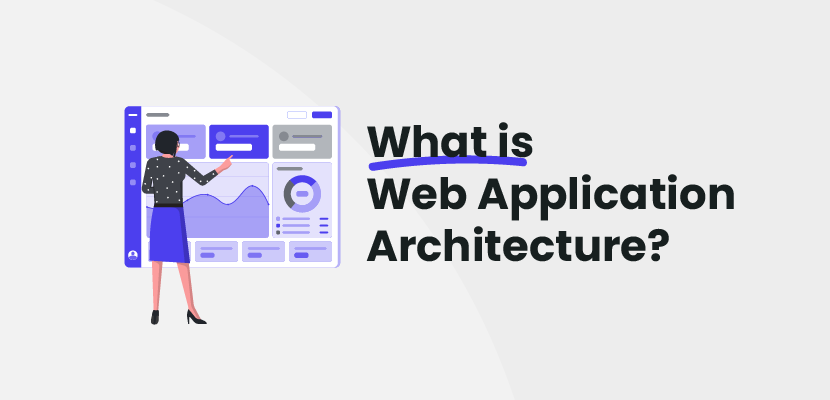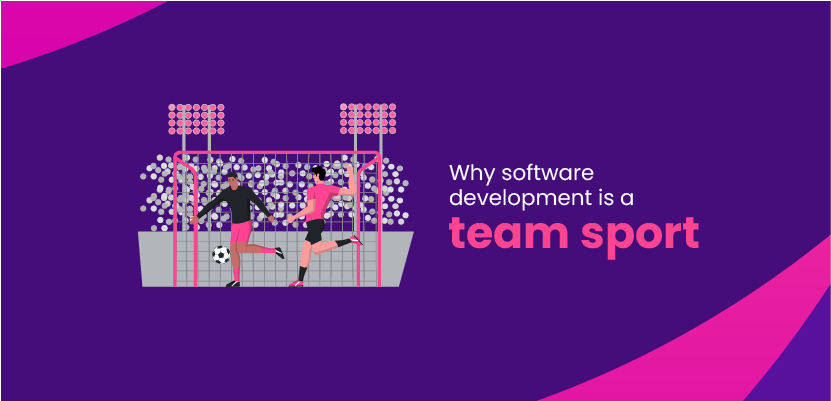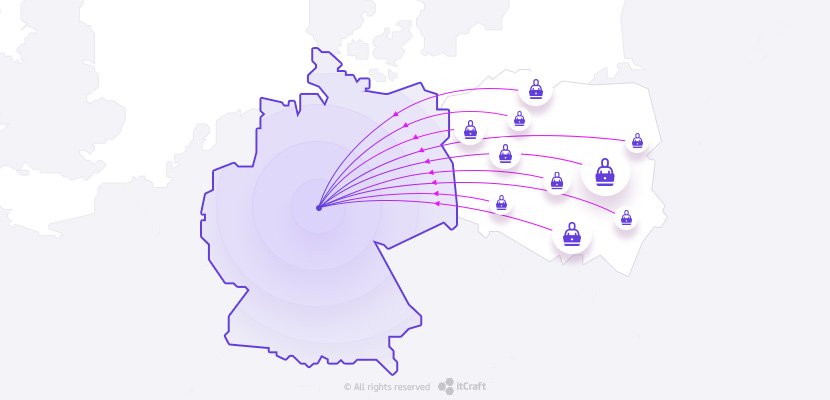What Is Web Application Architecture?

Bartosz Pieślak

Alexa Trachim

Architecture is a term that we associate with buildings. However, it can be used to describe many other things. Essentially, everything that has a particular structure and is organized in a certain way can be called architecture. As software developers, we build each digital product using best practices to guarantee a seamless customer experience. That means all features have to be accessible and logically placed, so the users will be able to find them and use them.
Table of contents
1. Web application architecture definition
2. Why is web application architecture essential?
3. Web application architecture types
4. Web application architecture – summary
Let us show you how exactly web application architecture is designed and the rules to apply when preparing it.
Web application architecture definition
A web application is built from several elements. The architecture determines how these components interact with each other. This way, everything can work as it should and the user can achieve all the goals they have. These parts include the user interface, databases and external applications.
An example? You probably know how websites and apps work. You click a button or a hyperlink and it takes you to another page where you can find the information you are interested in. All these connections are determined within the web application architecture.
Logically combining all the features is one thing, but time is also crucial. If the page loads too long, users won’t stay too long on it. Even though the architecture is responsible for a few different operations when the interaction between the app and the user happens, it has to be quick. Usually, it takes seconds or milliseconds to switch from one screen to another. When we click the link, the request is sent to a server and it responds by sending files to the browser to display the proper view.
What is involved in the web application architecture process?
Since we already described how it works, we should take a closer look at the involved parties. In the beginning, we have a web browser – something you are probably using at the moment. It shows the content of the application that is usually coded with HTML, JavaScript and CSS. The main responsibility of the browser is to be the intermediary between the user and the server.
As for the way websites and web apps are built, we recommend checking out our article about progressive enhancement that provides better accessibility for all, no matter their bandwidth, operating system and browser version.
Then we have the web application server (backend) where data is stored and processed. It is also responsible for integrations with external systems. Backend is usually done with languages like Node.js, PHP, Python or Java. It’s the central part of the app that is in control of all operations. The database server stores the whole required data and sends it to the web app server upon request.
Usually, these two parts are separate programs called “client-side code” and “server-side code”. The former accepts user inputs, while the latter responds to requests. A team of developers has to create this communication pattern and it’s their decision what will be the server’s reaction to the user’s input.
Why is web application architecture essential?
Actually, we should ask why a well-designed web app architecture is important. Every web application has some type of structure, but it’s not always good. If we take care of its quality, it will help our software work better and offer scalability in the future. Updating content, adding new functionalities and growing your web app can be possible only if its architecture allows you to do so. Not to mention, it can be enhanced to process requests faster.

Best practices when creating a web application architecture
As we mentioned, your architecture needs to be thought-through to be effective and support your business growth. There are a few things you should remember when preparing it:
- Simplicity is always the best. Overcomplicating features or navigation will make your users demotivated and, as a result, they will leave your software behind.
- Your product needs to solve concrete problems and it has to do it consistently. This way, using your web app will be intuitive and user-friendly.
- Your digital product has to have as short as possible response time and has to load with a blink of an eye.
- Finding space for analytical tools and A/B tests is required to measure your web app’s performance and test various solutions.
- Implementation of security measures is crucial to protect your users’ data and prevent it from being stolen or leaked.
- Also, you should develop defect-prevention features like more than a single point of failure, self-healing mechanisms and more.
- Find a way to create code that will be open for scalability and future growth.
Web application architecture types
There are many ways we can structure a web app. Not every type of architecture will be suitable for all products. There isn’t one perfect solution. That’s why knowing the possibilities in that department will help you to decide what you want to implement in your software.
Single Page Applications (SPA)
One of the most popular web app architecture types nowadays. All well-known digital solutions like Facebook, Gmail and Trello are SPAs. It means that when we navigate through them, we can click particular elements to get the desired information, but it won’t change the entire page, only a specific part.
For example, if you want to read an email from your co-worker, Gmail will display it for you, but it won’t change the surroundings like the menu, bookmarks, search field or folders.
Currently, business owners pick Single Page Applications because they are known for excellent UX – navigating through them is intuitive and logical. Performance-wise they offer short loading times, which is appreciated by users that don’t want to wait for features to work. In terms of scalability, SPAs also shine. Right now, it’s one of the best web app architectures out there.
Progressive Web Applications (PWA)
Another trendy type of architecture is PWA that is often used for e-commerce sites. It’s basically a mix between a web app and a native app. Some people claim that progressive web apps will replace native ones because they have several benefits that no other software has.
For example, PWAs can work without an internet connection. They do that by caching data from the last time the app was online. It can be pretty helpful when it comes to availability but also for web apps that have a lot of data to store, like online shops. This way, when users browse the offer, the products load in an offline mode.
All business owners that require native-like features and UI but want to save a bit of their budget should consider progressive web apps.
Multiple Page Application
Also known as Web 1.0, it used to be the most popular type of web app architecture, but now it’s considered out-of-date. It’s easy to develop and takes less time than other approaches, but, of course, there’s a catch. These apps tend to be slow because the server has to process huge chunks of data traveling between the database and the browser.
Moreover, multiple page apps require full-stack developers that can code back-end and front-end and they can be hard to recruit as now programmers specialize in particular areas of development.
It is recommended to pick modern web app architectures with better performance, even if they require more resources and time to be created. Your clients will be thankful for that.
Serverless architectures
You can outsource your server needs to a cloud provider that will take care of the architecture for you. Basically, it means that a third party operates the back-end of your web app. It can save you a lot of money and if you pick a robust service, it won’t necessarily be worse than having your own server.
Going serverless is an option that is becoming more and more popular because it requires less budget to begin the development process. However, it can get more expensive when it comes to maintenance, especially if we have to handle many users and when our backend operations are resource-hungry.
Web application architecture – summary
There is no doubt that a web app architecture has to be built with many aspects in mind. This structure was evolving throughout the years – from simple to more advanced possibilities. Right now, we can choose from several different options, but you should always pick one that suits your digital product most.
The architecture you will implement has to be secure, robust and functional. Talking with your IT provider about possible solutions is the best way to decide which direction to go. Trust someone with experience and knowledge about web app development. At itCraft, we consult all parts of the project to ensure it meets the needs and requirements of a particular client. Our individual approach allows us to get the best results.
Contact us and let’s collaborate. We will create a complete digital product for you. The software will be an essential part of your business growth.



